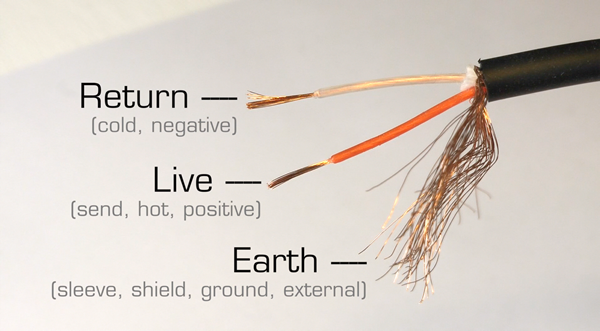Audio interconnection 02
Basic audio lead concepts
- Video
- Script
Welcome to this tutorial on basic audio lead concepts.
All home and project studios have a variety of interconnected audio devices such as ..
- microphones
- guitar amplifiers
- hardware keyboards, synthesisers and sound modules
- audio interfaces
- computer based DAWs
- hardware processors
- monitor loudspeakers
- etc
These devices are used to record, process, mix, and amplify audio signals.
Caption - Audio leads
A variety of different types of audio lead are used to connect audio devices together, in a process known as interconnection. Leads are sometimes referred to as interconnects, or cables. A lead comprises a length of cable terminated at one or both ends with a connector, either a plug or a socket. Some leads terminate in bare wires, for example a loudspeaker lead which is attached with some type of bare wire terminal.
Caption - Permenant leads (installation wiring)
Some leads are left permanently in place, so called 'installation wiring', such as those that link outboard equipment or a stage box to a patch bay. Sometimes these connections are referred to as 'lines' or 'tie-lines'.
Caption - Temporary leads
Other leads are only connected when needed, such as patch cords, guitar and microphone leads.
Caption - Connecting, or chaining, devices togther
Most jobs require 2 or more devices to be connected together in a chain.
Demonstration For example, in order for an electric guitar to be recorded, this chain of devices is required ..
- guitar to amplifier
- microphone to microphone pre-amplifier
- microphone pre-amplifier to analogue to digital converter
- analogue to digital converter to audio interface
- audio interface to DAW
- DAW to headphone amplifier
- headphone amplifier to monitor headphones
Caption - 'Physical' audio signal types
In order for audio signals to pass between these devices, it must be in the form of either ..
- an analogue electrical audio signal
- a digital electrical audio signal
- a digital optical signal
Caption - Single and multi signal/channel leads
Most leads carry a single mono or stereo signal, but others such as multi-core and optical leads can carry multiple channels of audio and are commonly used for installation.
Caption - Wires, cores or 'poles'
All analogue electrical and digital electrical audio leads have 2 or more wires, or cores, to carry the signals. Only fibre optic leads are different. Each core will be isolated from the others with a protective insulation surround and will carry one of three signal 'types' or 'poles'..
- Earth - also known as sleeve, shield, ground, and external
- Live - also known as send, hot or positive
- Return - also known as cold or negative

In many cables, the earth core does not have its own insulation surround, but is braided and wrapped around the live and return cores, in an attempt to shield them from outside interference.
Multi-core, or multi-channel, leads, will have multiple earth, live and return cores.
Caption - Identfiying leads
There are many variations of cable and connector types, each suitable for different types of signals and applications. Some are visibly different whist others are difficult to tell apart.
DemonstrationAES3 digital and mic leads look similar, both use XLR connectors, and have the same number and arrangement of wires, or cores, in their cables, but the electrical properties of the cores differ.
Caption - Categorising leads
It is possible to categorize leads as either analogue or digital, but because there are so many ‘flavours’ of both, this simple division isn't always helpful. It is true to say that analogue or digital signals must be converted in order to be mixed together, but this is also true of the analogue signals that electric guitars and synthesisers produce.
Caption - Stereo connections
In the studio, apart from headphone leads, almost all analogue stereo connections require 2 leads, 1 each for the left and right channels. Analogue surround sound connections require a lead for each channel. Here's a keyboard with a stereo headphone socket requiring a single lead, but with left and right line level outputs, for connection to a mixing desk or an analogue to digital converter, which require 2 leads.
Caption - RF interference and ground loops
The 2 most common problems associated with leads are radio frequency interference and ground loops. These issues are discussed in a separate tutorial in this series.
Caption - Thanks for watching
The script for this video, with accompanying images, can be found at projectstudiohandbook.com
We suggest you subscribe at our YouTube channel, and join our mailing list at our website to receive notification of new videos, blog posts and subscriber only extras.
Thanks for watching.